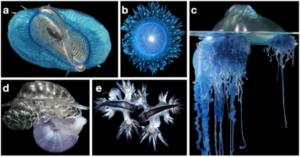Week 9: A Positive Spin On The Great Pacific Garbage Patch
May 25, 2023
Welcome back to my blog. This week I focused on how creatures are able to live on the Great Pacific Garbage Patch (GPGP) and how this is bringing a new perspective towards this issue. These species that live on the GPGP are known as Neuston species, a group of animals that live on the surface of the ocean. These animals include by-the-wind sailors(A), blue buttons (B), man-o-war jellyfish (C), slime-rafting venomous snails (D), and Blue sea dragons (E) (reference image). Just like humans, animals learn to adapt to the changes in their environment. Researchers have been studying how these adaptations have been happening and have found that a large variety of species are living on the GPGP. Though the garbage patch may be an unnatural ecosystem for wildlife, it acts just like a natural ecosystem such as the Sargasso sea, a large patch of seaweed known as sargassum in the Atlantic Ocean. When it comes to predators of neuston species, the predators get caught in the plastic while prey uses the plastic as protection to survive.
Learning about everything living in the GPGP brings a new perspective to the world when it comes to polluting the oceans but also cleaning up the ocean. This new perspective is that by cleaning up the GPGP, we are destroying these creatures’ homes and also catching and killing them in the process. Therefore it’s not that we shouldn’t clean up the ocean at this point but we should find a way that we clean up the ocean without harming these creatures.
Until next week’s blog.


Leave a Reply
You must be logged in to post a comment.